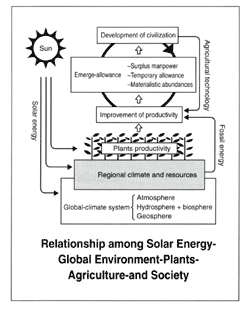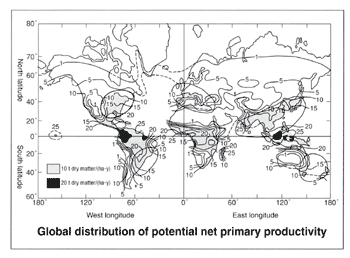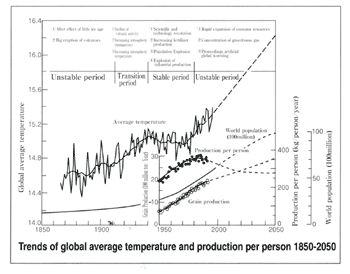|
I
From the Viewpoint of Food Production
Zenbei Uchijima
President
Miyazaki Municipal University
My name is Uchijima of Miyazaki Municipal University. I studied the relationship between agriculture and climate for a long time − about 37 years − at a laboratory of the Ministry of Agriculture, Forestry and Fisheries. I have shifted my direction somewhat to the realm of global environment since then and currently spending a considerable portion of my research on the issues of food production and global environment.
Today, I would like to talk about a rather basic approach for the population issue from the standpoint of food production.
We ourselves are living organisms, and organisms can be roughly divided into plants and animals. These organisms have three major characteristics. The first characteristic is that they are isolated and protected from the outside world by biomembrane consisting of macromolecule. The second characteristic is that organisms live by taking in vital energy, i.e. food, from the external world, and then metabolizing and eliminating it. The third characteristic is that organisms have the ability to reproduce themselves by using DNA information. One can define "organism" as an entity that controls these three abilities in a unified manner in the process of ontogenesis and phylogeny.
Individual organisms have a significant characteristic of ingesting vital energy, i.e. food, from the external world, and staying alive by metabolizing and assimilating it inside its body. Since we are unable to survive as an organism without this function, I think the issue of food is very important for our continued existence.
This figure shows the flow of energy between the sun, Earth, biosphere and noosphere. As for the amount of energy that flows in one year, the sun, which is shining at a distance of 150 million kilometres from our Earth, is putting out enormous amount of energy into space of 121.8×1029kj. The amount of solar energy that reaches the surface of Earth, located 150 million kilometres from the sun, accounts for about one-2 billionth of the energy emitted by the sun in one year. Forty-five percent of this one-two billionth of energy is spent on evaporating water from the surface of Earth, a planet known as "planet of water" Another 41% is lost through infrared radiation, which is not visible to us, and 13.7% is released in the form of sensible heat transfer.
Table(1)
You can say that the climatic conditions that enable the survival of organisms are created by these activities. Then what kind of energy does the biosphere − including our world population of 6.1 billion − use after seemingly having conquered Earth? The answer to this question is that we live on energy that has been fixed by plants. The solar energy fixed by terrestrial and aquatic plants accounts for mere 0.11% of the 28.5 × 1020 kj that reaches the Earth's surface. It is also estimated that the food energy − energy that can potentially be used for food − accounts for about one-hundred thousandth of the solar energy arriving on the Earth's surface.
This is what all organisms, all organisms living on Earth, rely on for subsistence. However, we human beings invented farming about 10,000 years ago and are currently producing a large volume of food thanks to this invention. To calculate this using the data for the latter half of the 1990s, we were obtaining 34.4 × 1015kj of food energy per year. It supports the lives of 6.1 billion people and a large number of cows − as many as 1.3 billion head. This energy quietly flows back into space in the form of invisible infrared radiation after giving rise to all kinds of phenomena including our intellectual and physical activities.
We human beings started using large quantities of fossil energy after the first industrial revolution that started around the end of the 17th Century. In particular, we are spreading our civilisation of science and technology throughout Earth by spending approximately 10 times more energy − energy derived from fossil energy and nuclear energy − than the food energy that we consume. And we are artificially creating the noosphere - a sphere that is largely different from that of other spheres.
| (拡大画面:108KB) |
 |
Fig(1)
Among various energy sources currently used by human beings − with the exception of nuclear energy − this food energy is energy arriving from the sun at present. It is fresh solar energy. In contrast, fossil fuel can be seen as solar energy that arrived on Earth during the old geologic era. It is fossilised solar energy.
So the fundamental difference between humanity and other organisms is the fact that all other organisms are living on fresh solar energy currently arriving from the sun while only human beings are using fresh solar energy of the present and solar energy from the past, that is, fossilised solar energy. Although we have built a magnificent civilisation by utilising this energy, we are exerting catastrophic influence on Earth.
Now let us take a look at agriculture that produces our food. This is what agriculture looks like when seen in terms of the solar energy system. As mentioned in the lectures by Dr. Matsui and Dr. Hoshi, the elements that comprise the global system include biosphere and noosphere, and the energy that enters from the sun drives the global climate system such as atmosphere, hydrosphere and geosphere to create global and local climates. Plant productivity of various regions on Earth is determined at the backdrop of these local climatic conditions.
Humanity has succeeded in converting this plant productivity into food productivity by using crops and livestock. Improvement of food productivity has given rise to leeway in terms of food that enabled people to have extra time, such as time for intellectual work, and culminated in development of civilisation.
Table(2)
This development of civilisation brought about technological development, which, in turn, propelled our progress over the last 10,000 years by being fed back to food production for further improvement of food productivity.
For this reason, agriculture and food production that support our existence − the existence of humanity − can be regarded as the world's oldest industry and the most important industry for the survival of humanity. This oldest industry can also be seen as the most important human activity that gave rise to and supported the civilisation. One can also say that the productivity of plants of each region existing in the global climate supports this activity.
Table(3)
As mentioned earlier, plants have their origin in the photosynthesising microorganisms that appeared on this planet about 4 billion years ago. All living organisms live on the products of photosynthesis. Therefore, plants can be likened to the "Green Atlas", the Green Giant that continues to carry all of the planet's organisms on his shoulders.
The power of this Green Giant depends on the amount of solar energy that has been absorbed and fixed by the plants, their net primary productivity. For this reason, one can say that net primary productivity of natural vegetation in a certain region represents the most important biological element that determines the activity level, biodiversity and the size of the ecosystem of the region.
A rough calculation of the productivity of each region using a climatological model shows that the present global climate conditions are influenced by the climate conditions shown in this figure and are changing dramatically in quantity and distribution.
| (拡大画面:101KB) |
 |
Fig(2)
Taking the example of high temperature and humidity, islands in Southeast Asia have annual plant productivity of nearly 30 tons per hectare. The regions indicated as shadow in the figure correspond to high productivity regions with high annual plant productivity exceeding 10 tons per hectare. You can see that such regions are extremely limited in the vast land areas of Earth.
Meanwhile, this irregular-shaped circle represents regions where agriculture has been practiced since prehistoric times, or since three to four hundred years ago in the case of New Continent. As you can see, humanity has subsisted by converting into food the plant productivity that had been made available by the natural environment and Earth throughout their long historical development in the form of crops and livestock.
| (拡大画面:137KB) |
 |
Fig(3)
Weather observation started worldwide in or around 1850. This figure here shows in a very straightforward manner the changes in global climate, the changes in population and the changes in food productivity over the past 150 years.
This shows the changes in the global average temperature. This shows the changes in total global population. And this shows the increase in production of grains, the world's most important food resource. This line represents the volume of grain production per person.
Global climate has changed dramatically over the time span of 150 years. After going up gradually from the 1920s to around 1945, the temperature slightly dropped over the next 25-year period after going through some fluctuations to maintain the temperature at an almost constant level. However, it started to rise sharply since the latter half of the 1970s. The man-caused phenomenon of global warming that resulted from massive use of fossil fuel is said to be at the background of this phenomenon.
table(4)
The world was producing about 600 million tons of grains per year in 1950. In the mid-'90s, grain production exceeded 2 billion tons. Thus the grain production per capita has been increasing steadily at the rate exceeding the rate increase in population during that period. However, a very pessimistic view is becoming increasingly dominant when it comes to what the future would hold. One of the predictions is that the rate of increase in food production would drop to half of what it is today.
The agricultural technology of today that attained more than threefold increase in grain production over the past 50 years can be referred to as high-productivity agriculture or high-yielding agriculture. You can also say that this high-productivity agriculture spread by using the four resources − environmental resources, biological resources, technological resources and energy resources − as required, in sets and at low prices.
When deploying this high-productivity agriculture in each region or country, it is very important to have a very sophisticated capacity for scientific and technological research and a highly developed industrial production system. When you look at the food exporting countries of the world today, they are primarily developed countries and not developing countries. It is an indication of the importance of various technological and resource utilisation capacities in the deployment of high-productivity agriculture.
I have mentioned that humankind learned to till the land about 10,000 years ago. Since then, many people have strived to increase production and obtain stable yield. In addition, new types of farming and crops have been created to suit the condition of each region. About 900 species of crops are currently being used for human consumption. In addition, 1,000 species of crops are used to produce industrial raw materials and 400 species are grown to produce feed and green manure.
Table(5)
|